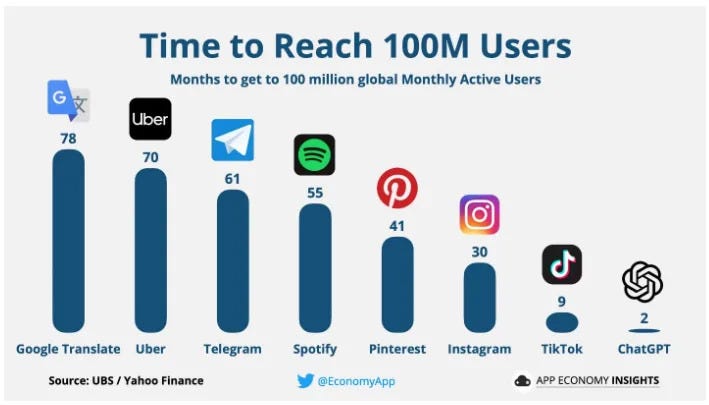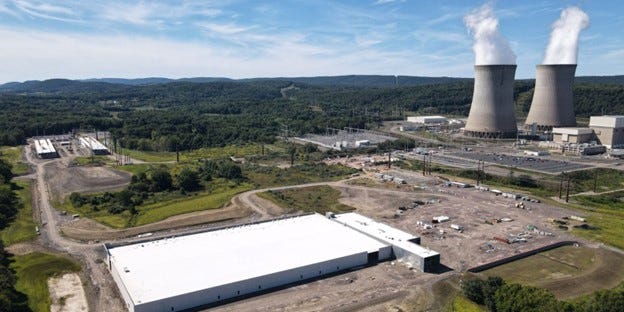Power Surge
Utilities and tech companies are finding unique ways to deliver electricity to power hungry data centers without destabilizing the grid
The release of ChatGPT in November 2022 heralded in an era of unprecedented public interest in artificial intelligence and its potential. As the below image demonstrates, ChatGPT reached over 100 million global users in just 2 months, a speed that absolutely crushed the user acquisition of well-known apps such as Uber, Spotify, and Instagram.

Given the above statistics, there’s a good chance you’ve asked ChatGPT a few questions or generated a handful of images through services like DALL-E and Midjourney. (Full disclosure: The header image of this article was generated via DALL-E).
What makes the explosion of interest in artificial intelligence unique, however, is the energy demands that these new data centers are putting on power grids. This is because the server racks that fill data centers and lend their processing power to AI-powered tasks use a lot of energy. From the Economist:
According to Christopher Wellise of Equinix, which rents out data centers, a pre-AI hyperscale server rack uses 10 - 15 kilowatts (KW) of power. An AI one uses 40 - 60 KW. It is not just computation that gobbles up electricity. Keeping the racks of GPUs cool requires just as much oomph.
For companies looking to maximize their profits on the global interest in artificial intelligence, these power requirements represent an obstacle, albeit one that can be overcome with considerable investments. Goldman Sachs has reported that tech companies are planning to spend over $1 trillion on artificial intelligence infrastructure over the coming years.
Algorithms or Atmosphere?
With all of the above in mind, large tech companies such as Amazon, Microsoft, and Google are finding that the booming demand for new AI-powered data centers is imperiling their carbon reduction plans. A snippet from Google’s 2024 Environmental Report highlights the balancing act these hyperscalers are playing:
In spite of the progress we’re making, we face significant challenges that we’re actively working through. In 2023, our total GHG emissions increased 13% year-over-year, primarily driven by increased data center energy consumption and supply chain emissions. (emphasis mine)
To summarize, being a leader in artificial intelligence offers mouth-watering future profits and leadership in a fast-growing field, but the associated energy demands that come from power-hungry data centers are putting carbon emissions and environmental goals at risk.
Managing AI’s Energy Appetite
The immense need for new data centers has brought utility companies, tech companies, and federal, state, and local governments together to find new solutions that don’t imperil environmental goals or stress the grid.
What’s emerged from these collaborations are a variety of solutions/options that depend on the location, available generation sources, and potential financial arrangements.
New life for nuclear?
With only 3 nuclear power plants entering commercial operation in the 21st century, nuclear power proponents have not had much to cheer about.
Nevertheless, in March 2024, Talen Energy sold a 960-megawatt data center campus to Amazon Web Services (AWS) for $650 million. The idea is that this power plant will provide electricity directly to the data center. Known as a “behind-the-meter” arrangement, this configuration allows companies to avoid transmission and distribution costs that normally come with getting energy from the grid.

Proponents of the deal argue that this is an excellent way to get carbon free electricity for energy hungry data centers. Opponents argue that this behind-the-meter configuration removes potential electricity from the grid, thereby raising prices for other consumers and reducing overall grid reliability.
Given the size of the deal and the associated power purchase agreement, nuclear power plant operators across the U.S. will be closely monitoring this deal in the hopes that they can fashion similar arrangements.
Power players
Other companies such as Microsoft are working closely with utilities to build energy infrastructure for their planned data centers. In Dublin, for example, Microsoft received permission last year to build an “unprecedentedly large-scale gas power plant.” This power plant will directly supply electricity to Microsoft’s data center at its Grange Castle site, thereby avoiding potential grid overload issues. Nevertheless, the fact that the new power plants will be gas powered is raising the ire of local politicians concerned about environmental impacts.
Grid Guarantees
One other way utility companies are looking to secure the necessary financial commitments to build new generating capacity is by encouraging data center operators to put more skin in the game.
To that end, in May, American Electric Power Ohio put forward a new proposed rate structure for data centers. Marc Retter, CEO and President of AEP Ohio laid out his case:
Demand for computing power from data centers, which require enormous amounts of electricity, is being fueled by artificial intelligence and other new technologies. AEP Ohio is seeing unprecedented demand from data center customers, especially in the Central Ohio area. While we see no concerns serving current or new residential and existing commercial or industrial customers, we need to ensure that the right long-term investments are made to the electric grid. We need accurate plans and solid commitments from large data center customers so the right facilities are built at the right time. This will help us keep Ohio open for business for all industries, while making sure customers aren’t paying for unused infrastructure.
Building a new power plants, regardless of the type, is an undertaking requiring significant investments and time. Utilities such as AEP Ohio are willing to build this additional generating capacity, but they want assurances that they’ll receive the ROI they’re projecting.
Key Takeaways
Data centers need a lot of electricity. This newfound demand is exciting for utility companies, but is putting a strain on a grid system that is in need of serious upgrades. Look for continued innovative solutions as utilities, tech companies, and governments collaborate to discuss tricky issues around clean energy, the interconnection queue, grid reliability, and infrastructure siting.
The demand for artificial intelligence is real, but, as of right now, it hasn’t yet unlocked any clear economic benefits brought about by enhanced productivity. Daron Acemoglu, a professor at MIT, has even argued that “truly transformative changes won’t happen quickly and few - if any - will likely occur in the next 10 years.” While the urgency and hype around artificial intelligence is real, the coming months and years will reveal how much of it is real versus imagined.




